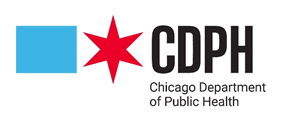Chicago Department of Public Health Weekly Media Brief, 05/17/2024
CDPH Public Information Office: media.cdph@cityofchicago.org

CDC Report Cites CDPH for Curtailing Measles
A new report in a Centers for Disease Control and Prevention (CDC) journal cites the rapid response of CDPH, with support from the CDC and other partners, for curtailing a measles outbreak in a Chicago new arrivals shelter. The analysis published Thursday in the CDC's Morbidity and Mortality Weekly Report estimates the recent outbreak would have likely been significantly worse if not for the rapid, coordinated response.
Starting on March 8, CDPH, supported by the CDC, Cook County Health and other community healthcare partners, implemented a rapid public health response to a confirmed case of measles in a shelter. The response included a mass vaccination campaign, shelter residents being screened for measles symptoms, and people with suspected or confirmed measles being isolated. These interventions reduced the spread of measles and successfully reduced the outbreak size and duration, according to the report. It has been four weeks since the last confirmed case of measles in Chicago.
"Don't Die High" Harm Reduction Campaign
CDPH has collaborated with several community organizations to form the Chicago Methamphetamine Task Force to address the destructive use of methamphetamine among Black gay, bisexual and other men who have sex with men (GBMSM) in the City of Chicago. This week the partnership rolled out their “Don't Die High” harm reduction campaign to encourage people to carry fentanyl testing strips and naloxone, also known by the brand name NARCAN®.
While treatment numbers show that methamphetamine drugs, such as crystal meth, are used by people across ages, ethnicities, and other demographic indicators, the use of these drugs is having an outsized adverse impact among communities of Black gay, bisexual, and other same gender-loving men. Too often, these drugs are laced with the synthetic opioid fentanyl, which is a major contributor to overdoses.
The new campaign responding to this crisis includes community-generated content and images to encourage people to test for fentanyl, carry naloxone in case of overdose, and be aware of resources for those seeking treatment and support. More information is available at chicago.gov/dontdiehigh.
Chicago's Summer Strategy to Combat Opioids
CDPH outlined a summer strategy Wednesday to combat opioid overdoses, which have increased recently and are a main contributor to the racial life expectancy gap in Chicago. CDPH is doubling down on harm-reduction strategies designed to prevent overdose fatalities with a three-pronged strategy focusing on the most impacted communities: Naloxone distribution, overdose education and linkage to treatment.
Dr. Ige appeared before the City Council Committee on Health and Human Relations today and said the city and Cook County have seen spikes in opioid overdoses in recent weeks. For example, during one recent 24-hour period there were 50 suspected opioid-related overdoses in the city. In 2022, there were more opioid-related overdose deaths in Chicago (1,397) than homicides and traffic crash fatalities combined. Sixty-five percent of those fatalities were among Non-Latinx Black individuals and 78 percent were men.
For more details on the City's efforts to curb opioid overdoses and close the racial life expectancy gap, see the full press release from earlier this week.
CDC, CDPH Monitoring Meningococcal Disease
The Centers for Disease Control and Prevention (CDC) is reporting a nationwide increase in meningococcal disease, a rare but serious bacterial infection that can be severe and even deadly. Similar to national trends, CDPH is also monitoring an increase in cases of invasive meningococcal disease since January 2023. Compared to 1-3 cases per year in 2017-2022, there were seven cases in 2023 and eight cases in 2024 to date.
CDPH recommends seeking medical attention immediately if you or your child develops symptoms of meningococcal disease, which can include fever and chills, fatigue, vomiting, cold hands and feet, severe aches and pains, rapid breathing, diarrhea, or, in later stages, a dark purple rash. While symptoms of meningococcal disease can at first be similar to the flu, they worsen rapidly, and the disease can become life-threatening within hours.
For more information on meningococcal disease, see the full press release from earlier this week.
###




